Sadr, designated as Gamma Cygni, is a star located in the northern constellation of Cygnus, forming the intersection of an asterism of five stars called the Northern Cross.
Key Facts & Summary
- Sadr is located at around 1,800 light-years / 560 parsecs away from the Sun.
- Sadr is the second brightest star in the constellation of Cygnus, after Deneb. This star is also among the brightest stars in the night sky.
- Its location marks the intersection of the Northern Cross, a bright asterism that dominates the summer sky in the northern hemisphere.
- Sadr has an apparent magnitude of 2.23, and an absolute magnitude of -4.54.
- In comparison to our Sun, Sadr is around 33,023 times brighter, yet it is several times younger, having an estimated age of around 12 million years.
- Sadr has around 12.11 solar masses and a radius of 150 times that of our Sun.
- Sadr is a supergiant star of spectral type FB8 lab, appearing yellowish-white in color.
- This star has evolved away from the main-sequence and it will eventually go supernova.
- The radial velocity of Sadr is around -7.5 km / -4.6 mi per second.
- Sadr has a rotational velocity of around 15 km / 9.3 mi per second. The spectrum of this star shows some unusual dynamic features, such as variations in the radial velocity of up to 2 km / 1.2 mi per second, occurring on a time scale of 100 days or more.
- The average surface temperatures on Sadr are very similar to our Sun’s, at around 6,100 K.
- The surface gravity on Sadr has been estimated at around 1.02 cgs.
- The star is surrounded by a diffuse nebula called IC 1318, or the Gamma Cygni region.
- Sadr is the primary component of a multiple star system cataloged as WDS J20222+4015A.
The star’s name, Sadr, is derived from Arabic and it translates to “chest.” The same word gave rise to the name of the star Schedar – Alpha Cassiopeiae.
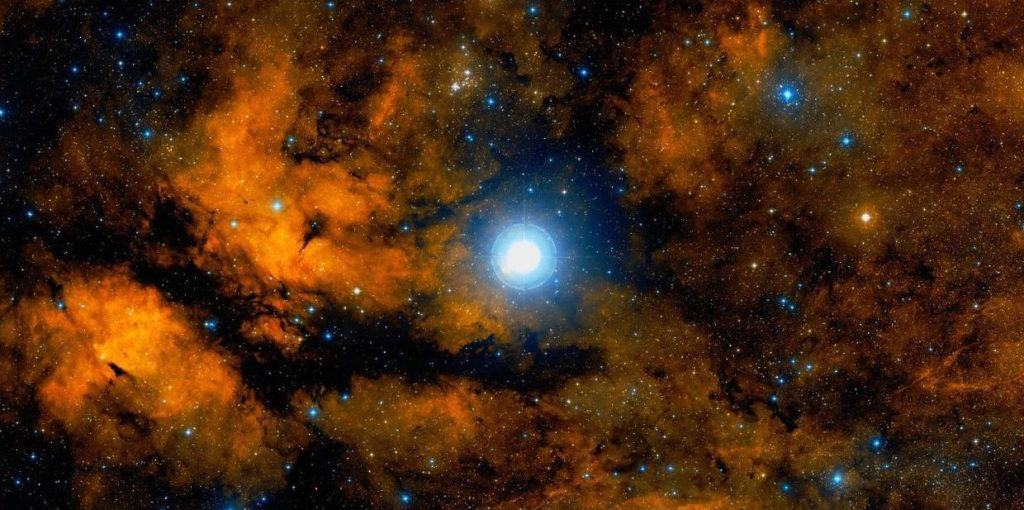
In the catalog of stars of Al Achsasi Al Mouakket, Sadr was designated as “Sadr al Dedjadjet” – translated into Latin as Pectus Gallinae, meaning the “hen’s chest”.
The star’s position marks the celestial swan’s chest, thus the reason for its naming.
Formation
Sadr formed at around 12 million years ago from an interstellar medium of gas and dust. Gravity pulled the swirling gas and dust together until it reached the critical temperature, giving birth to the second-brightest star in Cygnus, named Sadr.
It is quite a young star and the interstellar medium from which it was born was probably abundant in elements such as hydrogen, thus the reason for its short lifespan, as Sadr will eventually go supernova.
Distance, Size, and Mass
Sadr is located at around 1,800 light-years / 560 parsecs away from the Sun. Though it is extremely far away, Sadr can be seen with the naked eye.
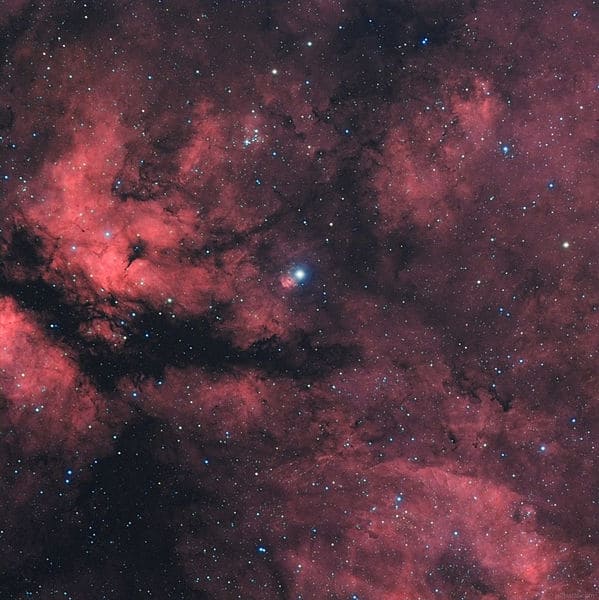
Sadr has 12.11 solar masses or 1.211% of our Sun’s mass, and around 150 solar radii or 15.000% of our Sun’s radius, thus Sadr is more than 300 times the size of our Sun.
Other Characteristics
Sadr is a supergiant star, yellow-white in color, and it is of spectral type FB lab. Though it is a very young star, it has already evolved away from the main-sequence, its radius expanding several times, and its mass predicting its end in a supernova.
Sadr has an apparent magnitude of 2.23 and an absolute magnitude of -4.54. It is a very bright star, being around 33,023 times brighter than our Sun. However, Sadr’s surface temperature is only at around 6,100 K, slightly hotter than our Sun.
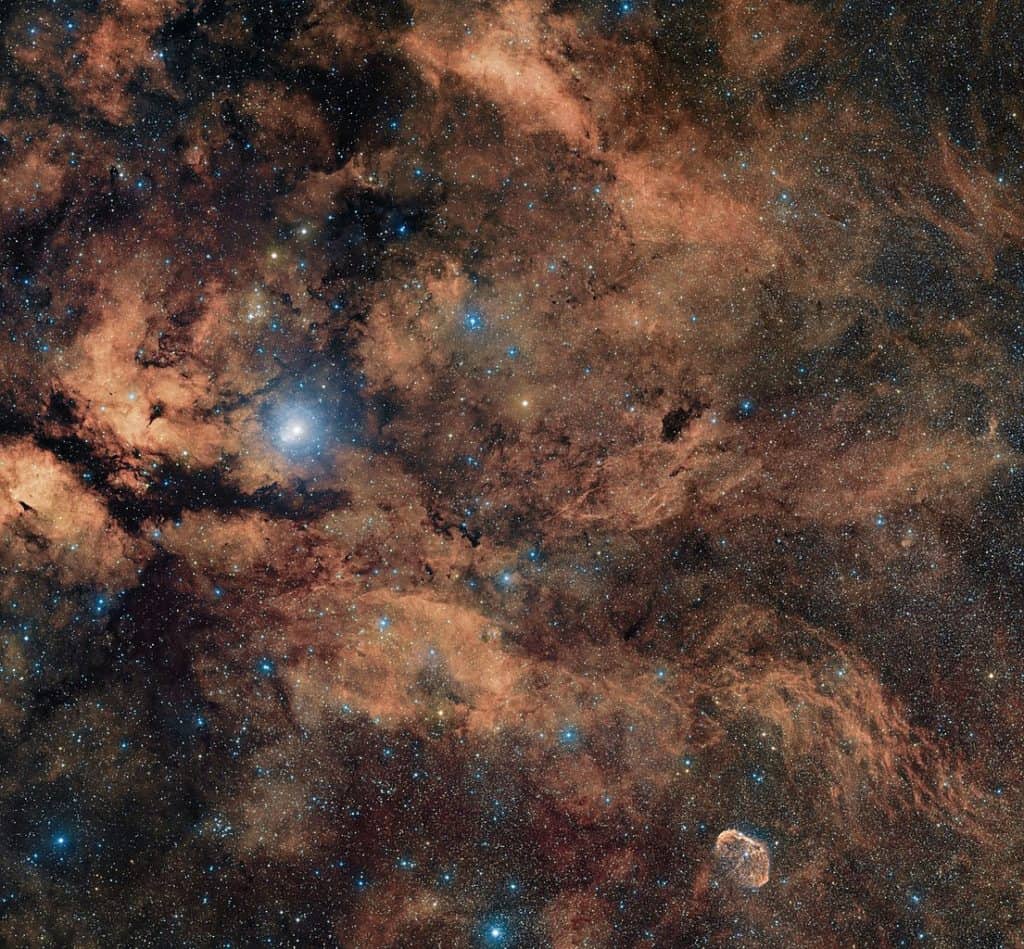
The radial velocity of Sadr is around -7.5 km / -4.6 mi per second. Sadr has a rotational velocity of around 15 km / 9.3 mi per second. The spectrum of this star shows some unusual dynamic features, such as variations in the radial velocity of up to 2 km / 1.2 mi per second, occurring on a time scale of 100 days or more.
Nebula
Sadr is enveloped by an emission nebula designated as IC 1318. This is not unusual since there are several nebulous regions at the center of the Northern Cross asterism.
IC 1318 is also known as the Gamma Cygni Nebula or the Butterfly Nebula. However, the nebula isn’t physically related to the star Sadr, it is merely in the same line of sight.
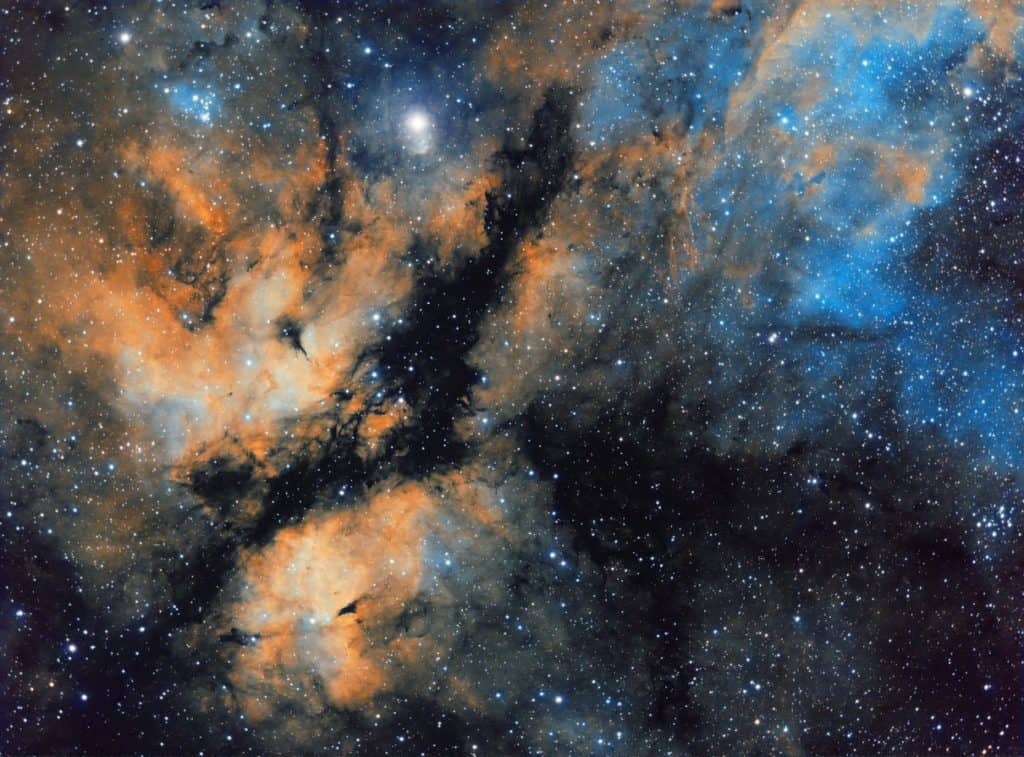
The nebula itself is located far away from the star, at a distance of around 4,900 light-years. There is a blue O9-class star that illuminates the nebula, however, it is obscured by interstellar dust and much about the star remains unknown.
Stellar System
Sadr is the primary component of a multiple star system cataloged as WDS J20222+4015A. The star is often referred to as the A component, while the secondary component, cataloged as CCDM J20222+4015BC, is called the BC component. The secondary component is separated by 40 degrees from Sadr and is just a visual companion.
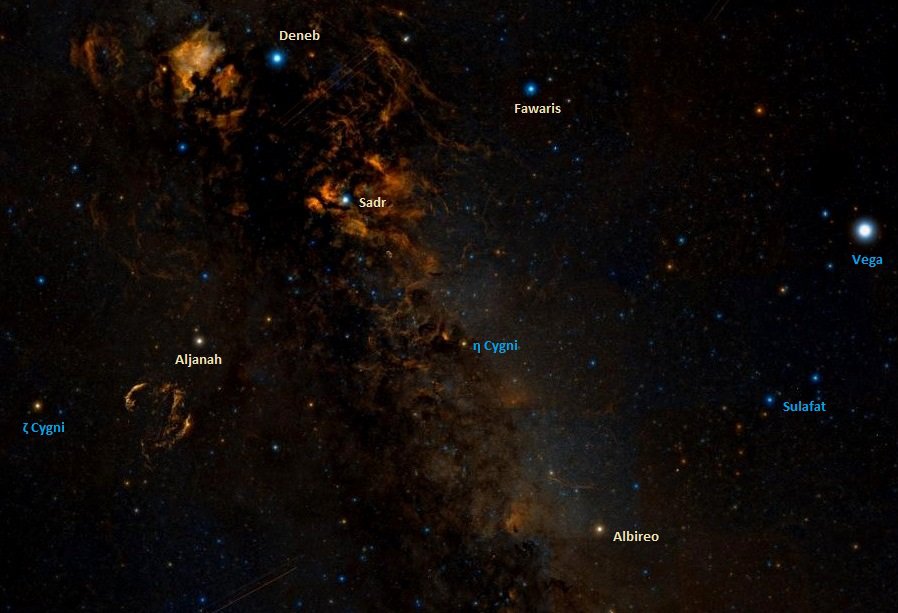
Location
The star, Sadr or Gamma Cygni, is located in the constellation of Cygnus, the celestial swan. It marks the swan’s chest. Sadr is the second-brightest star in this constellation.
The constellation of Cygnus is among the largest northern constellations in the night sky, occupying an area of 804 square degrees.
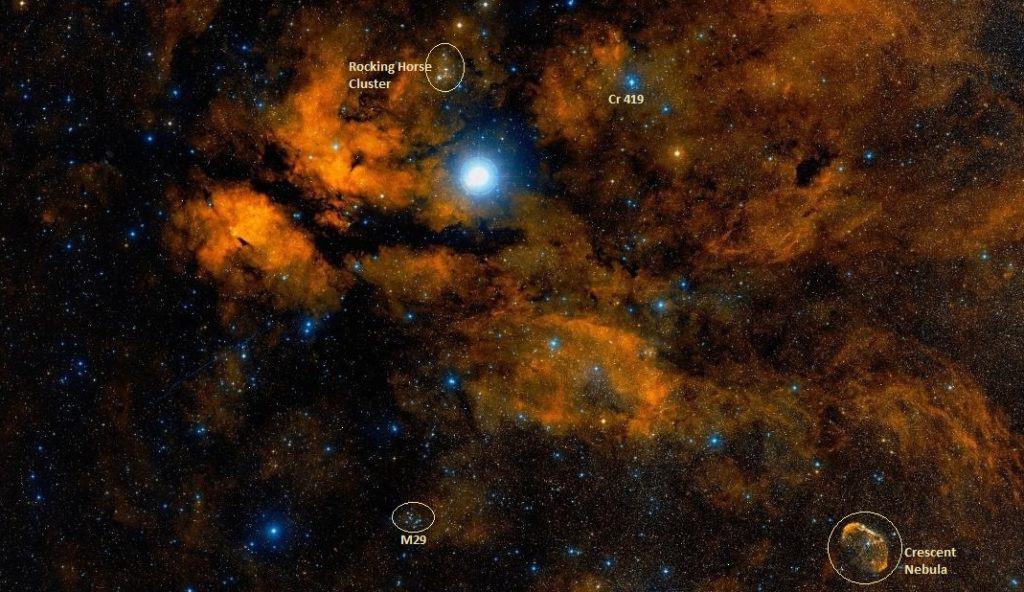
This constellation is known for its asterism, the Northern Cross, and the bright stars Deneb – the 19th brightest star in the night sky, and Albireo, a famous contrasting double.
The Northern Cross asterism is situated within a larger asterism known as the Summer Triangle, which is formed by the bright stars Deneb, Vega, and Altair.
Sadr itself is near several interesting deep sky objects such as the Rocking Horse cluster, the open cluster Collinder 419, Messier 19, or the emission nebula NGC 6888, also known as the Crescent Nebula, situated at only 2 degrees southwest from Sadr.
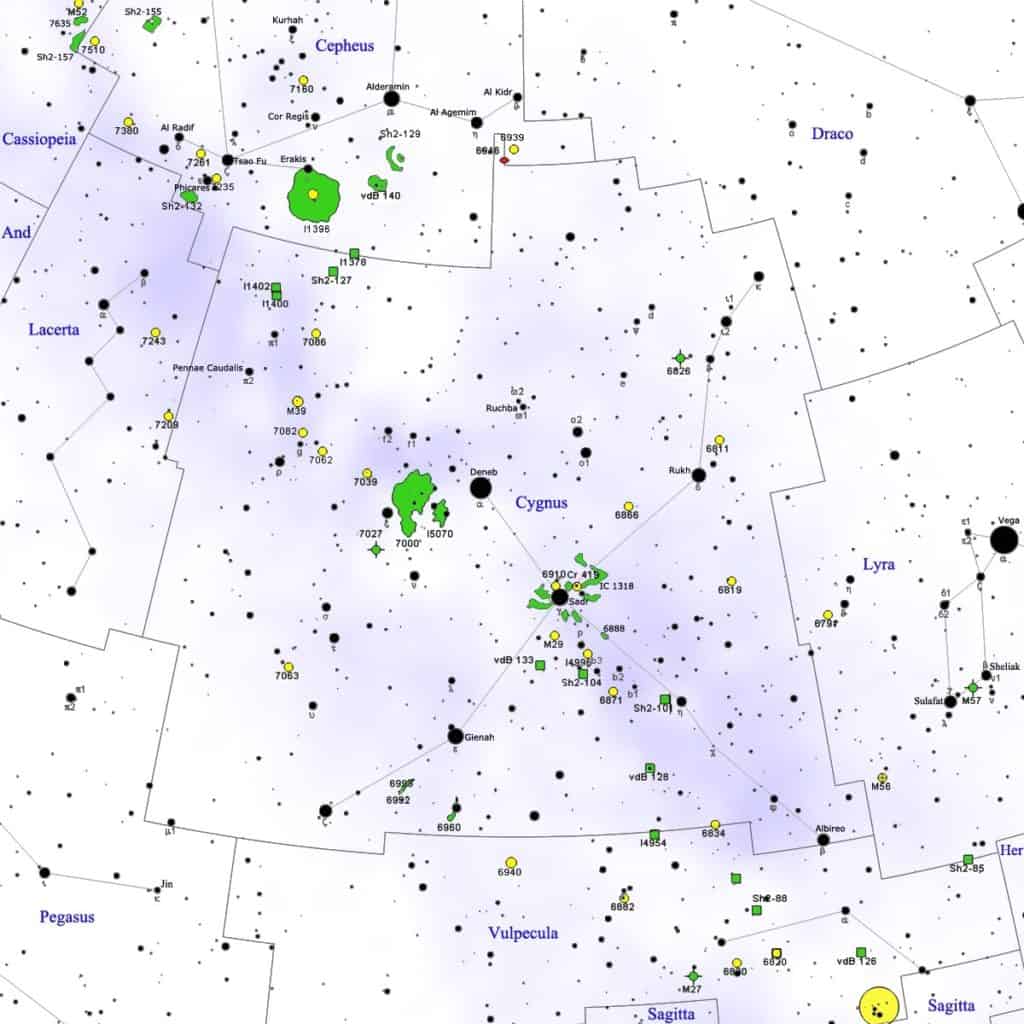
The best time to observe the stars and other deep sky objects in the constellation of Cygnus is during the month of September.
The Future
Sadr has reached the supergiant stage of its stellar evolution and thus its radius has expanded and it will probably continue to expand several times its former size.
Since Sadr is so massive, it will one day go supernova and illuminate a big portion of the night sky, despite being such a young star.
Did you know?
- The Chinese know Sadr as the First Star of Celestial Ford – Celestial Ford being a Chinese asterism formed by Deneb, Fawaris, 30 Cygni, Nu Cygni, Tau Cygni, Upsilon Cygni, Zeta Cygni, and Aljanah.
- Sadr lies close to the instability strip and its spectrum is markedly like that of a Cepheid variable star.
- The spectrum of this star has been used to classify other stars since 1943.
Sources:
Image Sources:
- https://www.star-facts.com/wp-content/uploads/2019/10/Sadr-1240×617.jpg?189db0&189db0
- https://upload.wikimedia.org/wikipedia/commons/thumb/a/a8/Sadr_JeffJohnson.jpg/599px-Sadr_JeffJohnson.jpg
- https://www.star-facts.com/wp-content/uploads/2019/10/IC-1318.jpg?189db0&189db0
- https://www.star-facts.com/wp-content/uploads/2019/10/Sadr-Region.jpg?189db0&189db0
- https://www.star-facts.com/wp-content/uploads/2019/10/Northern-Cross.jpg?189db0&189db0
- https://www.star-facts.com/wp-content/uploads/2019/10/Sadr-Crescent-Nebula-Rocking-Horse-Cluster-Messier-29.jpg
- https://www.star-facts.com/wp-content/uploads/2019/09/Cygnus-constellation.jpg
